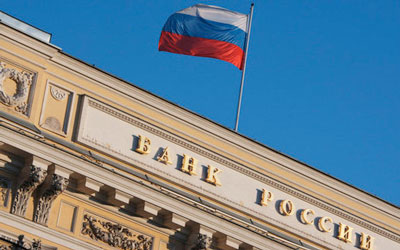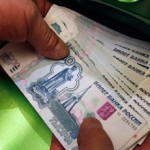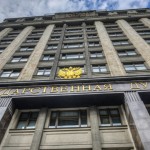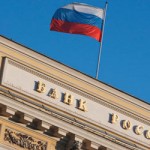Bank of Russia Halts Foreign-Currency Purchases, as Ruble Hits Five-Month Lows

Central bank stops buying U.S. dollars for reserves in bid to balance inflation and growth measures
Russia’s central bank, whose credibility has been tested over the past year by runaway inflation and a volatile currency, is coming sharply into focus as it tries to tame inflation without sending the economy into a deeper recession.
On Wednesday, the Bank of Russia said it had suspended daily purchases of U.S. dollars and euros for its reserves a day earlier, as the ruble weakened beyond 60 against the dollar and 67 against the euro for the first time since March.
The decision “indicates that the central bank is looking to strike the right balance between the desire to continue cutting rates and the need to keep inflation under control,” said Ivan Tchakarov, chief economist at Citigroup Inc. in Moscow.
The ruble strengthened in response to news of the move, the latest in a series of currency-policy shifts, hovering at 59 to the dollar by the end of the trading day in Moscow.
The central bank spent billions of dollars to buy rubles in 2014, aiming to prop up the currency, but allowed it to float freely late in the year, saying it would intervene only if market moves proved a major threat to financial stability.
The Bank of Russia returned to the market in mid-May, this time reining in strength in the ruble by buying as much as $200 million of foreign currencies a day. It said it meant to bring its gold and foreign-exchange reserves back to around $500 billion in the next three to five years. As of July 17, the reserves stood at $358.2 billion.
The central bank said in an email that it suspended those interventions because volatility in currency markets has increased, in line with earlier pledges to limit the impact of its moves on the ruble exchange rate.
Analysts at Sberbank CIB said the decision to halt foreign-currency purchases “risks confusing the market as to whether the central bank has indicated a [dollar/ruble rate] of 60.0 as the upper band of its comfort zone.”
Bank of Russia came under fire last year after the ruble slid wildly, briefly hitting 80 to the dollar in December, sending panicked residents to exchange booths and ATMs.
Renewed ruble weakness in recent weeks, mostly driven by a slump in oil prices, could scuttle hopes for big cuts to the central bank’s lending rates to revive the country’s economy this year. The bank has warned the risk of inflation could limit the scope for monetary easing.
Inflation has been a weak spot for the central bank. The annual pace of price growth has remained above 15% for months, far from the 4% target. Western sanctions, together with oil prices that have halved since a year ago, have sent the commodity-dependent economy into recession for the first time since 2009. Government data this week showed that the economy was 4.2% smaller in June than it was a year earlier.
On Friday, the Bank of Russia will have to balance inflation and growth risks as policy makers meet to set rates. The majority of analysts predict rates will be reduced, though less sharply than earlier this year. The central bank has slashed the key rate four times this year, from 17% to 11.5%. This time, the central bank is widely expected to trim the key rate by another 0.5 percentage point.
The suspension of foreign-exchange interventions indicates the central bank “remains vigilant with respect to how the weaker currency may translate into higher inflationary expectations,” Mr. Tchakarov said.
The recent ruble weakness has raised concerns that another rate cut would put extra pressure on the currency, spurring inflation further. Renaissance Capital, which expects a rate cut this week, said the likelihood that rates will remain steady has increased.
Meanwhile, as yields on investments in Russia slide lower, following central-bank rates, some international investors are scaling back their bets on the country. The capitalization of the Russian stock market, measured by the benchmark ruble-traded Micex index, has declined 14% compared with this year’s peak, reached in mid-February.
“Russia was the big investment story a couple of months ago. With oil prices having gone south again, Russia no longer looks as attractive,” said Zsolt Papp, a portfolio manager at J.P. Morgan Asset Management, which oversees $1.8 trillion in assets.
Mr. Papp bought Russian bonds earlier this year when prices were lower. He has reduced oil-and-gas-related investments broadly over the past few weeks.
Other investors are more optimistic. Alexander Moseley, a portfolio manager at Schroders, said last year’s ruble slump was the result of an unusual combination of collapsing oil prices, geopolitical tensions and the central bank losing control over inflation expectations.
“Now geopolitical risks are stable and the central bank has reasserted its credibility through rate cuts. It’s now really only the oil price,” said Mr. Moseley, whose firm oversees $474 billion in assets. He said he would buy oil-related investments, including in Russia, when energy prices fall to what he considers extreme levels.
Paul McNamara, a portfolio manager at GAM Holding AG, which oversees $130 billion in assets, said Russia is in the same category as other big commodity-exporting countries like Brazil, South Africa and Indonesia.
“Absent a rebound in oil, it’s very hard to get enthusiastic about the ruble,” said Mr. McNamara, who bought Russian bonds earlier this year and has no plans to sell now.
Source: WSJ – Bank of Russia Halts Foreign-Currency Purchases, as Ruble Hits Five-Month Lows



























